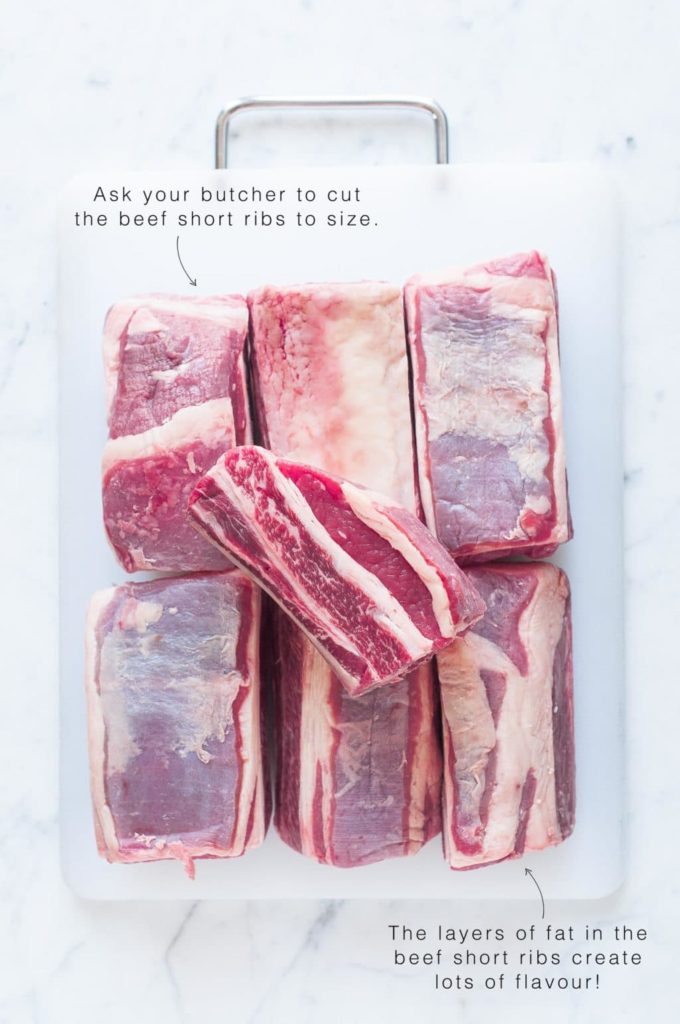Beef chuck short ribs
Galbi” is the Korean word for “rib”, and the dish is usually made with beef short ribs. Traditionally, galbi is cut beef chuck short ribs expose one smooth bone along the short edge with the meat uniformly filleted in flat layers. An alternative cut, “LA galbi”, also known as a flanken cut, features cut bones peeking out along the long edge. The method was developed by Korean immigrants in Los Angeles to accommodate the thinner rib-eye cut preferred by American butchers.
Jeju Black pig, is popular in Jeju Island. As pork ribs are smaller, marinated dwaeji-galbi often consists of pork ribs mixed with shoulder meats. Softer cuts of beef, such as from a cow or heifer, are preferred when grilling galbi. Properly grilled, the dish is a glossy, dark-reddish brown with a smoky, sweet taste. The meat should easily fall from the bones. If used, pork shoulder meat is carved into thicker slices of around 2. Deeper cuts are made when scoring the surface to allow the marinade to penetrate the meat.
Galbi is grilled, typically by the diners themselves, on grills set in the tables. The meat cooks for a short time on medium high heat on a lightly greased gridiron over glowing charcoal. The remaining marinade is brushed on during grilling to produce a glazed finish. Korean Short Ribs – City Kitchen”. A Hard-to-Kick Habit: Korean Barbecue Short Ribs”. Short ribs are a cut of beef taken from the brisket, chuck, plate, or rib areas of beef cattle. They consist of a short portion of the rib bone and the surrounding meat, which varies in thickness.

Banfield notes that the term “short ribs” comes from the fact that the cut of meat contains only a portion of each long beef rib. Using American butcher’s nomenclature, short ribs may be taken from the brisket, chuck, plate, or rib areas of beef cattle. The serratus ventralis muscle defines the area in the beef carcass from where short ribs come, and is the preferred muscle tissue for short ribs. This muscle originates near the second rib, and covers most of the rib cage. The latissimus dorsi muscle lies atop the serratus ventralis muscle, and is separated from it by a layer of fat.
It adds thickness to chuck and rib short ribs, but is less prized by chefs than the serratus ventralis muscle. They consist of what remains of the rib in this area after the rib chop is removed. British cuts of beef, showing the various cuts of short ribs. Short ribs, by definition, are not the entire length of rib.
When the carcass is cut across the bone to create strips of meat with multiple rib bones, the short rib is known as a “flanken cut. These may also be known as crosscut ribs, Eastern European-style ribs, Hawaiian-style ribs, Jewish ribs, Korean-style ribs, or “kosher ribs”. Retail meat shops often do not differentiate between short ribs which come from the brisket, chuck, plate, and rib. In the United States, short ribs from the plate are generally the least expensive cut, followed by medium-priced short ribs from the brisket and chuck, and premium-priced short ribs from the rib area. Beef short ribs are the equivalent of spare ribs in pork, with beef short ribs usually larger and meatier than pork spare ribs. Boneless” short ribs are cut from either the chuck or plate, and consist of rib meat separated from the bone. Boneless country-style short ribs”, however, are not true short ribs.
Short ribs are particularly popular in Chinese, Japanese, Jewish and Korean cuisine. Short ribs generally require long periods of cooking in order to break down the connective tissues in the meat and make the meat tender. Methods of preparation include braising, stewing, and sous-vide. Pot-au-feu is a classic French method of cooking short ribs. Flanken is a traditional Eastern European Jewish short rib dish, and serves as the origin of flanken cut of short ribs. Flanken-cut short ribs are boiled in broth with onions and other seasonings until the meat is very tender and the broth is rich.